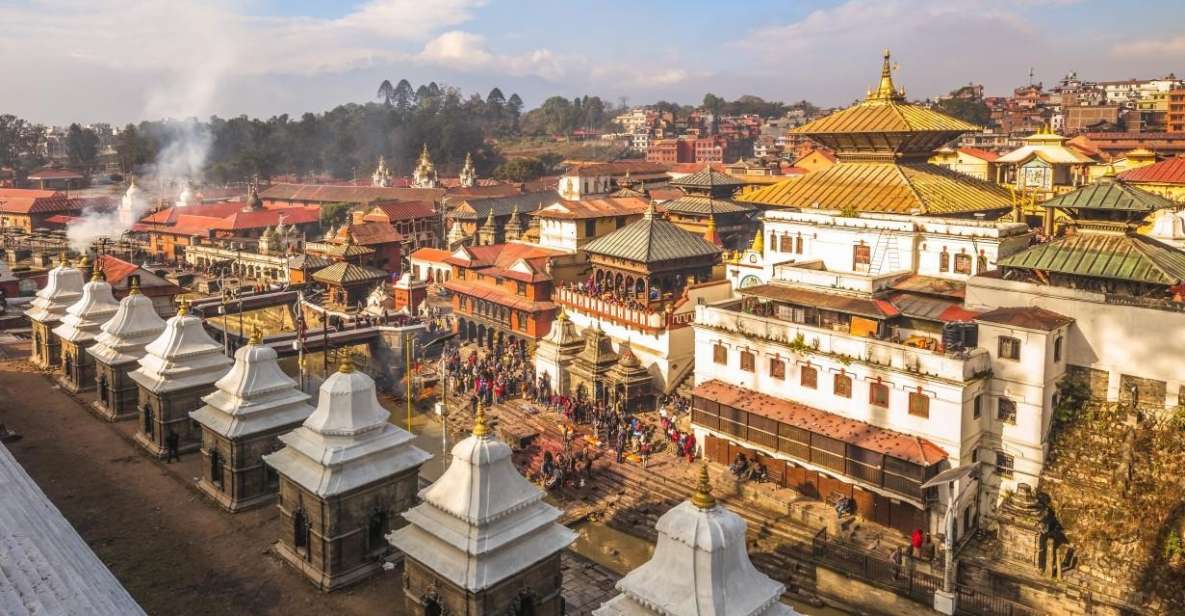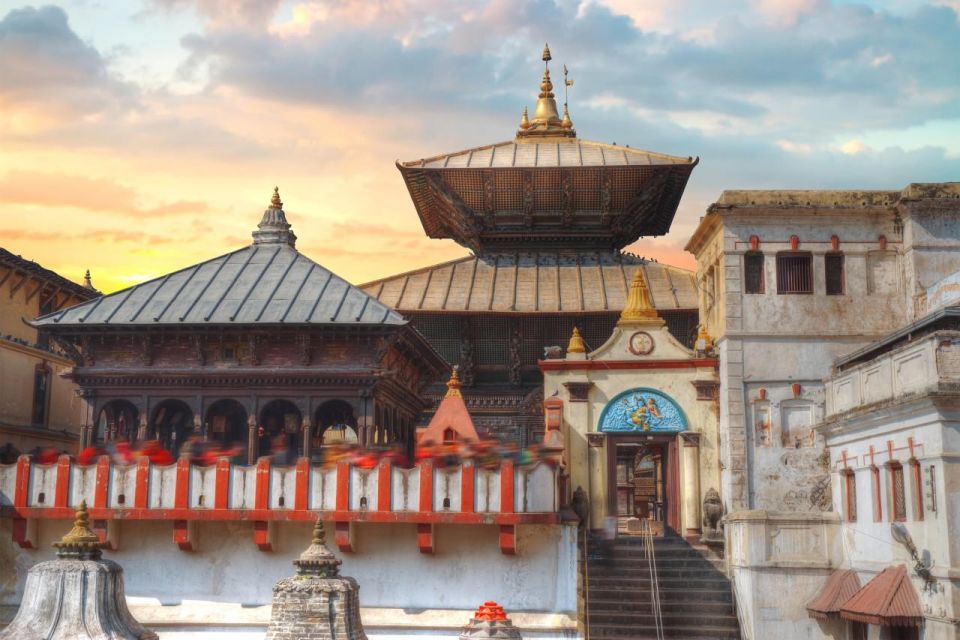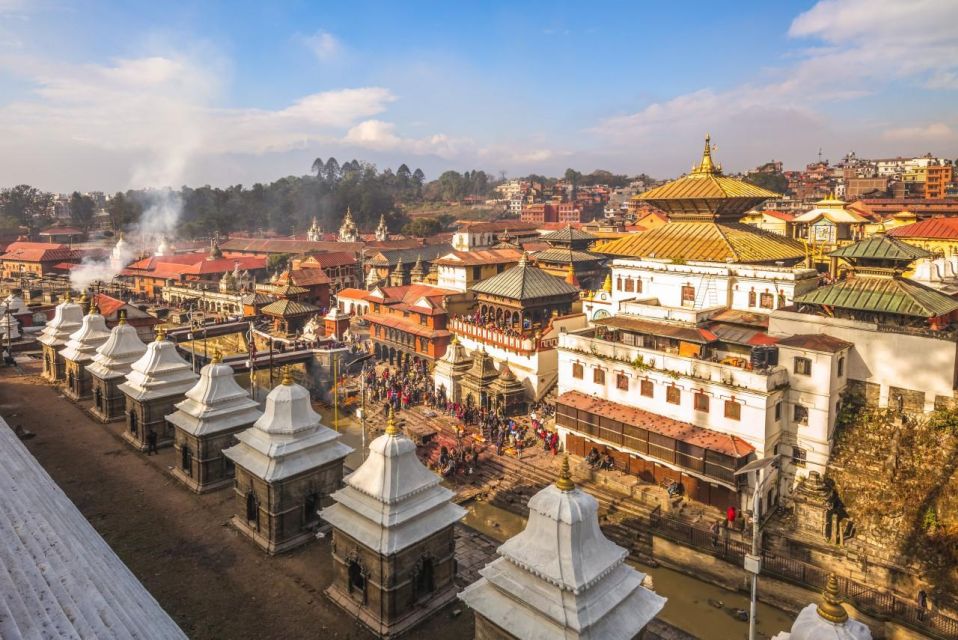Cremation Rites in Kathmandu
Amidst the ancient alleys of Kathmandu, the flickering flames of cremation pyres illuminate the night sky, embodying a timeless tradition that transcends the boundaries of mortality.
The rituals at Pashupatinath Temple offer a profound insight into the cultural tapestry of Nepal, intertwining spirituality with the earthly realm in a mesmerizing dance of tradition.
As the smoke curls towards the heavens, a sense of mystique hangs in the air, beckoning visitors to unravel the layers of significance woven into these sacred practices, revealing a tapestry of beliefs and customs waiting to be explored.
Key Points

- Cremation rituals in Kathmandu reflect deep-rooted Hindu traditions and beliefs.
- Witness the interplay between tradition, faith, and the cycle of life and death.
- Sadhus offer spiritual guidance and insights on life and death.
- Explore architectural heritage and cultural significance at Pashupatinath Temple.
Cultural Significance of Cremation Rituals

Cremation rituals in Kathmandu hold profound cultural significance, reflecting the deep-rooted traditions and beliefs of the Hindu community in Nepal. These rituals aren’t only religious customs but also integral cultural practices that have been followed for generations.
The act of cremation symbolizes the Hindu belief in the cycle of life, death, and rebirth, where the body is returned to the elements. Family members perform specific rites and ceremonies during the cremation process, guided by traditional practices that have been preserved over time.
The cremation rituals in Kathmandu provide a glimpse into the rich tapestry of Nepalese culture, showcasing how religious beliefs intertwine with everyday life in this vibrant society.
Hindu Beliefs and Traditions

Hindu beliefs and traditions in Kathmandu permeate every aspect of daily life, intertwining spiritual practices with cultural customs that have endured for centuries.
-
Ritualistic practices: Hindu ceremonies and rites are meticulously followed, with specific rituals for various life events.
-
Religious customs: Observing traditions like puja (prayer ceremonies), respecting elders, and celebrating festivals are integral to Hindu life in Kathmandu.
-
Sacred texts: The teachings of ancient Hindu scriptures like the Vedas and Upanishads guide religious practices and beliefs.
-
Caste system: Despite evolving over time, the caste system continues to influence social interactions and religious roles in Kathmandu’s Hindu community.
The rich tapestry of Hindu beliefs and traditions in Kathmandu reflects a deep-rooted spiritual connection that shapes the lives of its inhabitants.
Spiritual Insights From Sadhus

Amidst the vibrant tapestry of Kathmandu’s spiritual landscape, Sadhus offer profound insights into ancient wisdom and spiritual practices. These holy men, embodying the essence of Sadhu spirituality, can be found around Pashupatinath Temple, engaging in meditation and deep contemplation.
Visitors have the opportunity to interact with them, gaining a unique perspective on life, death, and the divine. During mourning ceremonies, Sadhus play a significant role in providing spiritual guidance and support to the bereaved families, offering solace and wisdom during times of grief.
Their presence within the temple compound adds a spiritual depth to the experience, allowing visitors to witness firsthand the interplay between tradition, faith, and the eternal cycle of life and death.
Architectural Wonders at Pashupatinath
At Pashupatinath Temple, the intricate architectural wonders stand as testaments to centuries of cultural heritage and spiritual significance. The temple’s design reflects a blend of historical significance and symbolic architecture, captivating visitors with its rich symbolism and intricate details. Here are four key features that make the architectural wonders at Pashupatinath Temple truly remarkable:
-
Pagoda Style Structures: The temple complex boasts stunning pagoda-style buildings, showcasing traditional Nepalese architecture.
-
Wood Carvings: Elaborate wood carvings adorn the temple, depicting mythological stories and religious motifs.
-
Golden Spire: The gilded spire of the main temple gleams under the sun, symbolizing spiritual purity and divine presence.
-
Sacred Courtyards: The temple grounds feature sacred courtyards where rituals and ceremonies have been conducted for generations, preserving the site’s cultural legacy.
Practical Tips for Visitors
For a smooth and enriching experience, visitors to the Pashupatinath Temple complex should familiarize themselves with practical tips before embarking on their journey.
When visiting this sacred site, it’s essential to respect visitor etiquette by dressing modestly and removing shoes before entering certain areas.
To fully immerse in the cultural significance of the cremation rites, it’s recommended to observe quietly and refrain from taking photos out of respect for the grieving families.
Engaging with locals respectfully can enhance the experience, offering a deeper insight into the traditions and rituals practiced at the temple.
Remember to stay hydrated, wear comfortable footwear, and be prepared for warm weather.
Common questions
How Long Does a Typical Hindu Cremation Ritual at Pashupatinath Temple Last?
A typical Hindu cremation ritual at Pashupatinath Temple can last for several hours. These rituals hold deep cultural significance, honoring traditions and beliefs. The duration of rituals allows for a respectful and meaningful farewell.
Are There Any Specific Rules or Customs That Visitors Should Follow While Observing the Cremation Rituals?
Visitors observing Hindu cremation rituals should follow cultural etiquette and respect sacred customs. Behave respectfully, maintaining silence, and refraining from taking photos. It is essential to dress modestly, remove footwear, and honor the solemnity of the ceremony.
What Is the Significance of the Location of Pashupatinath Temple for Hindu Cremation Rituals?
The location of Pashupatinath Temple holds immense cultural significance for Hindu cremation rituals. It is a sacred site where spiritual practices intersect with belief systems, honoring tradition and serving as a solemn place for the final rites.
Can Visitors Participate in Any Aspects of the Cremation Rituals or Ceremonies at the Temple?
Visitors can witness Hindu cremation rituals at Pashupatinath but are discouraged from actively participating. To respect cultural norms and ritual etiquette, observers should maintain a respectful distance and follow participation guidelines while experiencing this solemn cultural tradition.
Are There Any Specific Times or Days When the Cremation Rituals Are More Likely to Take Place at Pashupatinath Temple?
Visitors may witness cultural practices and religious beliefs surrounding cremation rituals at Pashupatinath Temple. Specific days or times for these ceremonies vary. Engage with the solemn Hindu customs and architectural wonders of the temple complex.
Last Words
Embarking on a journey to witness the cremation rites in Kathmandu is a profound experience that offers a deep insight into the spiritual and cultural traditions of Nepal.
From the ancient rituals at Pashupatinath Temple to the mystical encounters with Sadhus, every moment is filled with cultural significance and spiritual revelations.
Exploring the architectural wonders of this UNESCO World Heritage site adds another layer of awe and appreciation for the rich history and traditions preserved in this sacred place.